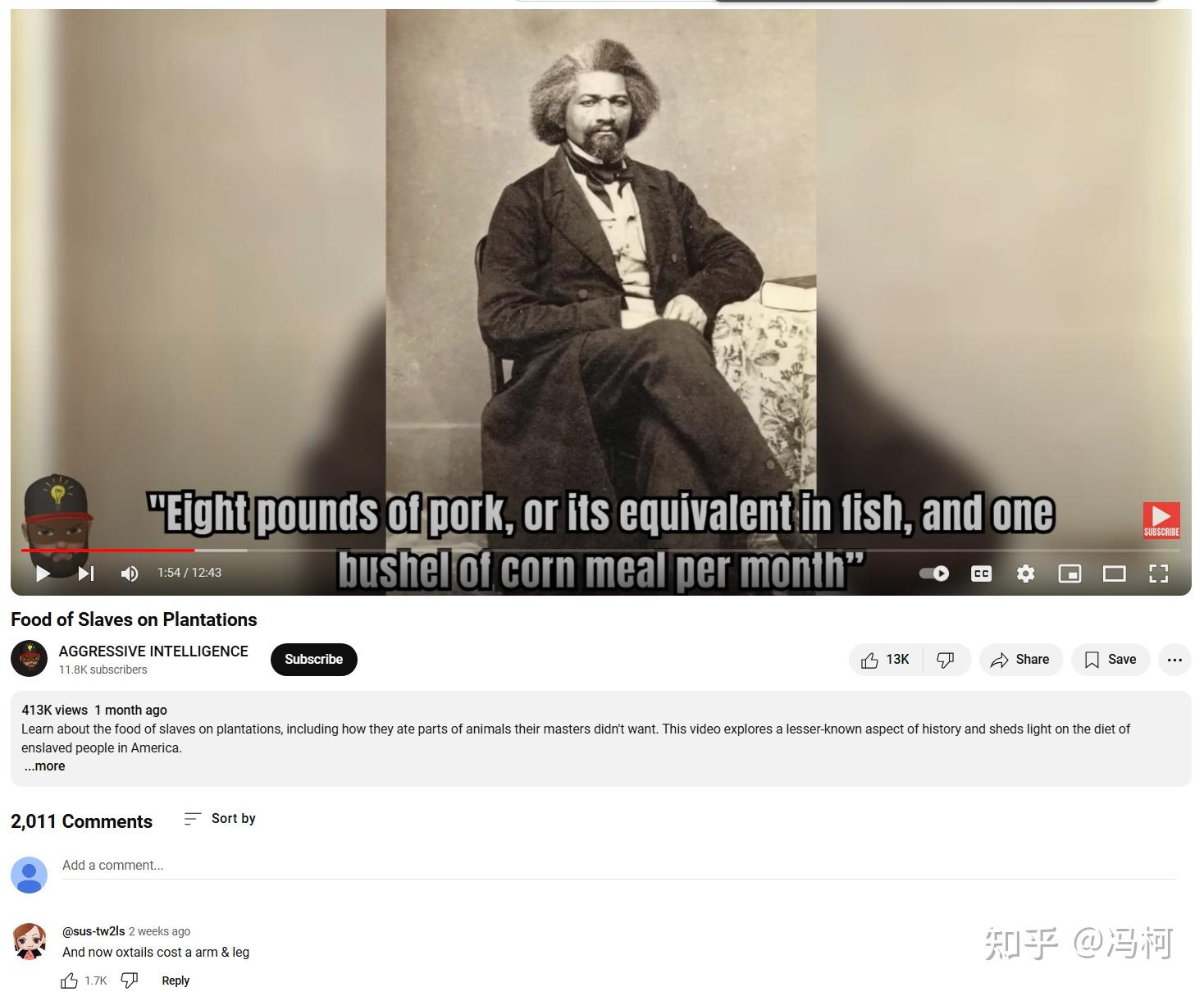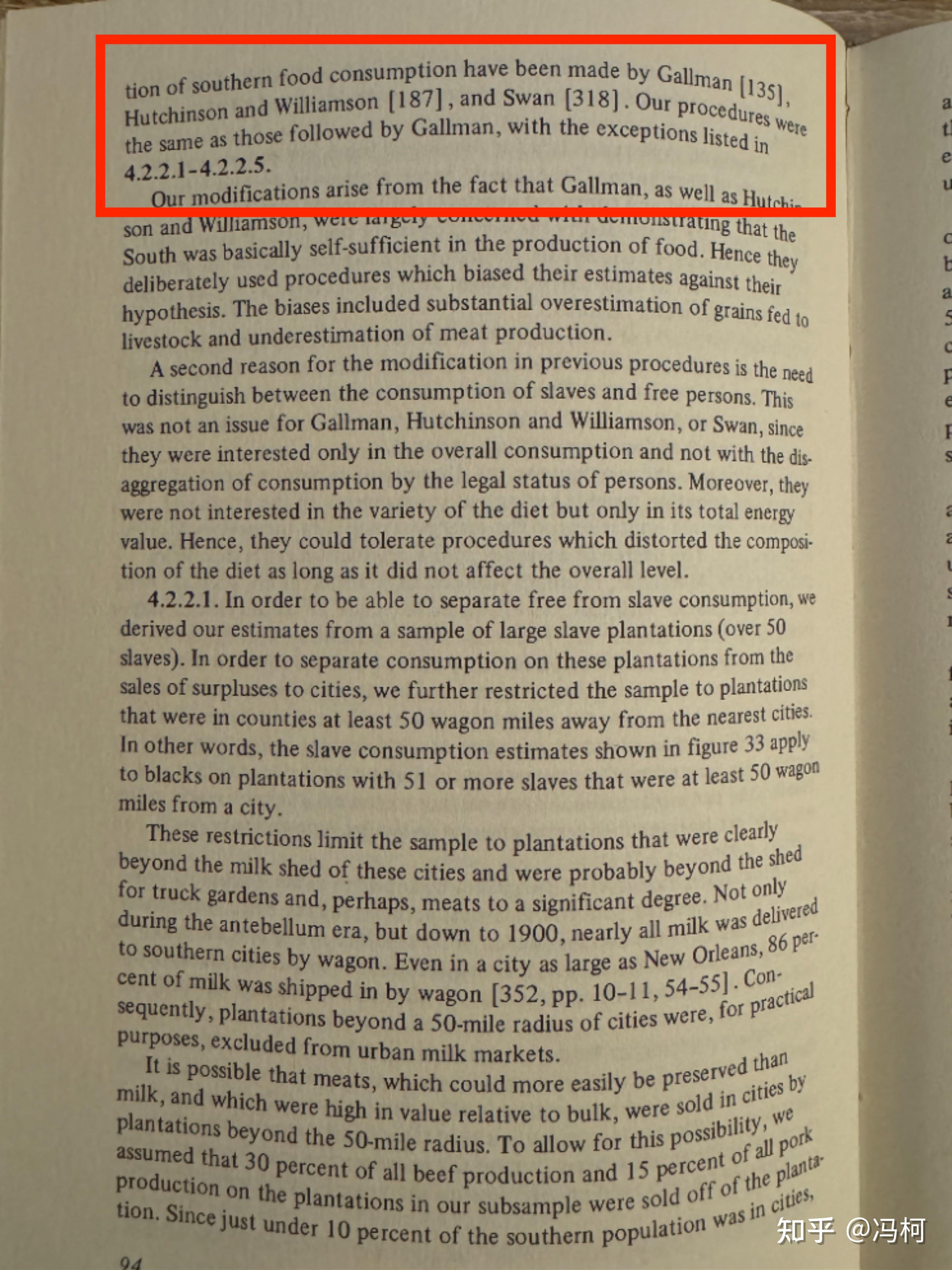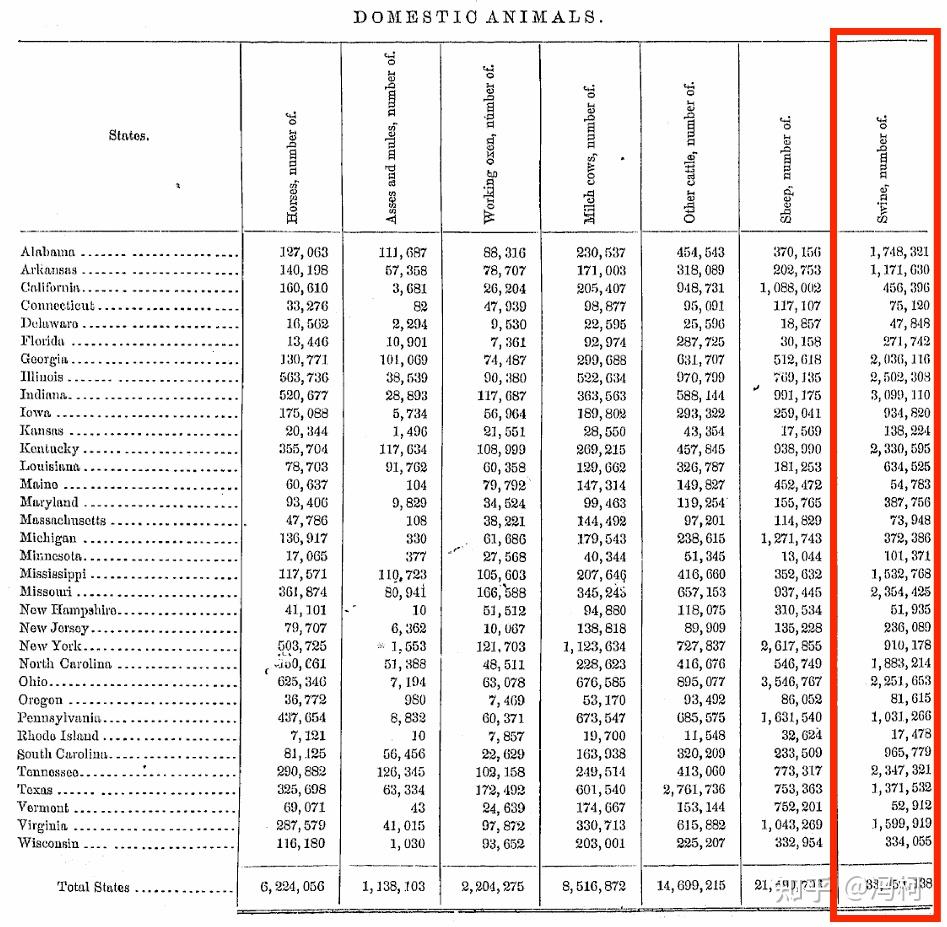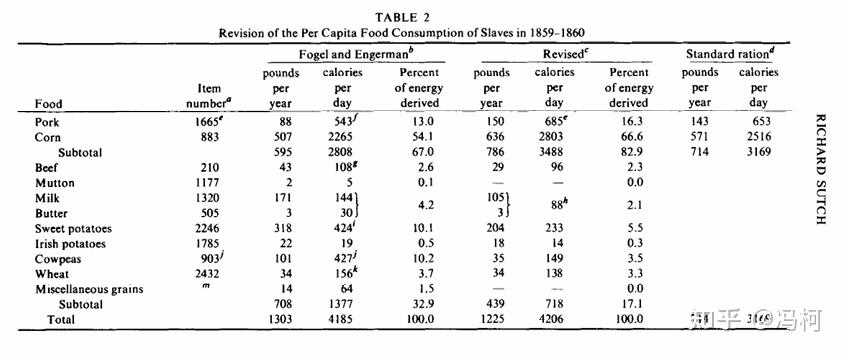黑奴的伙食怎么样?
学术界目前公认的结论是:十九世纪五六十年代黑奴每年人均肉类消耗量在一百磅以上,这一结论有大量史料互相印证。
先看看黑奴们是怎么说的。
北卡罗莱纳大学的Documenting the American South数据库中收录了大量19世纪的黑奴自述传记,只需搜索Narrative或Autobiography即可找到,其中不少记录了他们为奴时的食物供应量。
下面列举一些黑奴自己说的肉制品供应量。(请注意肉类消耗量和肉制品供应量的区别——消耗一百磅的肉能供应的培根是少于一百磅的)
- Slave Life in Georgia: A Narrative of the Life, Sufferings, and Escape of John Brown, John Brown 佐治亚州
Once a fortnight, or perhaps once a week, we get about two ounces to a quarter of a pound of old bacon, which is generally alive with "skippers," or honey-combed by them.
每人每周或每两周2盎司(56.7克)到四分之一磅(113克)的旧培根(生虫了),最低约合每年3.2磅。
- Narrative of the Life and Adventures, Henry Bibb 肯塔基州
When we arrived there, we found his slaves poor, ragged, stupid, and half-starved. The food he allowed them per week, was one peck of corn for each grown person, one pound of pork, and sometimes a molasses.
每人每周1磅猪肉,约合每年52磅。
- Incidents in the Life of a Slave Girl, Harriet Jacobs 北卡罗莱纳州
On that night the slaves received their weekly allowance of food. Three pounds of meat, a peck of corn, and perhaps a dozen herring were allowed to each man. Women received a pound and a half of meat, a peck of corn, and the same number of herring.
男人每周3磅的肉,可能有一打(十多个)鲱鱼;女人每周1.5磅肉,同样数量的鲱鱼,最低约合每年78磅。
- Autobiography of James L. Smith, James L. Smith 维吉尼亚州
The allowance for the slave men for the week was a peck-and-a-half of corn meal, and two pounds of bacon. The women's allowance was a peck of meal, and from one pound-and-a-half to two pounds of bacon; and so much for each child, varying from one-half to a peck a week, and of bacon, from one-half to a pound a week.
男人每周2磅培根,女人每周1.5至2磅培根,最低约合每年78磅。
- Narrative of the Life of Frederick Douglass, Frederick Douglass 马里兰州
The men and women slaves received, as their monthly allowance of food, eight pounds of pork, or its equivalent in fish, and one bushel of corn meal Their yearly clothing consisted of two coarse linen shirts, one pair of linen trousers, like the shirts, one jacket, one pair of trousers for winter, made of coarse negro cloth, one pair of stockings, and one pair of shoes; the whole of which could not have cost more than seven dollars.
每人每月8磅猪肉或等量的鱼,约合每年96磅。
- Life and Narrative of William J. Anderson, Twenty-four Years a Slave, William J. Anderson 密西西比州
Now, hear what our food was. We were called up on Sunday evenings, and had a peck of corn measured to us, shelled, or enough corn to make a good peck, two or three pounds of pork or beef. This was our allowance for a week; but to continue the punishment for my running away he would not allow me any meat for several weeks, and kept me in chains some two months, this was to cow me down in degradation like the rest of the slaves, which was hard to do.
每人每周2至3磅猪肉或牛肉,最低约合每年104磅。
- Twelve Years a Slave, Solomon Northup 路易斯安那州
Each one receives, as his weekly allowance, three and a half pounds of bacon, and corn enough to make a peck of meal.
每人每周3.5磅培根,约合每年182磅。
- The Life of John Thompson, a Fugitive Slave, John Thompson 马里兰州
The provision for each slave, per week, was a peck of corn, two dozens of herrings, and about four pounds of meat. The children, under eight years of age, were not allowed anything.
每人每周4磅肉,约合每年209磅。
- Narrative of the Life of Moses Grandy, Moses Grandy 北卡罗莱纳州
Their masters come once a month to receive the money for their labour: then perhaps some few very good masters will give them two dollars each, some others one dollar, some a pound of tobacco, and some nothing at all. The food is more abundant than that of field slaves; indeed it is the best allowance in America: it consists of a peck of meal, and six pounds of pork per week; the pork is commonly not good, it is damaged, and is bought as cheap as possible at auctions.
奴隶的"the best allowance in America"是每人每周6磅不好的猪肉,约合每年313磅。
当然,我们应该注意到上面的数据是有偏向性的。能在那个时代活下来,逃到北方,记录自己分到多少肉的,更可能是能力较强或待遇较好的黑奴。同时也应该注意到,那个年代能在北方得到资助出版的黑奴自述是持批判奴隶制的立场,更可能低估而非高估实际分到的肉制品量。因此,这并不妨碍得出结论:在19世纪,每年能分到几十斤肉制品的黑奴并非个案,部分黑奴甚至每年能分到上百斤的肉制品。
黑奴能生产出这么多肉制品吗?出版于1840年的一本美国农业指南[1]第397页提到,240英亩玉米的秸秆(人不吃的副产品)加上1.25英亩Clover和1.25英亩的土豆可养育40头猪,平均每头猪需要6英亩的玉米地副产品。
文献[2]及其引文中提到,在不同的农场中,一个黑奴平均需要处理3至10英亩的土地(实际的人均耕地更多,很多农场的耕地没有被充分利用)。按照[1, 2, 8]中的数据,用这些土地上副产品喂养的猪足以满足黑奴一年几十斤的肉制品配给量。
上述的估计只是一个下限,如果不养猪,这些副产品就白白浪费了。实际上,上述方法并不是当时广泛采用的最优养猪方法。当时美国南方实际的养猪方法参考[11],可以看到奴隶主还会用粮食来喂猪,用更少的耕地生产更多的猪肉。生产猪肉所需资源的具体计算还可以参考[5, 6, 8, 12]。
相比于世界上其他地区,美国的黑奴有着很高的人均耕地量。这样的耕地量迫使黑奴不得不一天工作十几小时,而农场主则拿走了这些耕地上方便储存运输的经济作物的大部分利润(包括棉花、蔗糖、玉米等),每年给黑奴的几十斤劣等肉制品只是为了保证黑奴工作强度的副产物。
黑奴一年能拿到多少肉是客观的事实,应当用数据回答。拿到这些肉是否令人满意则是另一回事,取决于工作强度、人身待遇、社会环境等因素。对黑奴来说,他们有着极高的体力劳动强度,日常遭受虐待,没有人身自由,没有社会地位,身边又有养尊处优的农场主作为参照,即便一年能吃上几十斤劣等肉,也有通过抗争来争取更好生活的动机。
对于处在现代发达地区的人来说,大部分都不需要参与如此高强度的体力劳动,饮食和生活上有着丰富得多的选择,吃多少肉更多是取决于吃不吃得下,愿不愿意花钱的问题。如果把所有可支配收入都花在买肉上,相信大部分人每年都能买上上吨的肉,而黑奴是无论如何也拿不到,吃不下这么多的。拿黑奴的肉食摄入量和现代人的肉食摄入量直接对比是不恰当的。
有读者提到几份黑奴的自述不够有代表性。实际上,"19世纪的美国黑奴能拿到每年数十斤的肉制品并非个案"这一结论有众多史料互为印证。下面按从直接到间接列一些。
1. 当事人的自述。这是最直接的史料。我随便搜索了一下,就找到了来自六个蓄奴州的八个黑奴反映他们身边的黑奴能每年拿到数十斤的肉制品。除了十九世纪出版的黑奴自述,在二十世纪三十年代,美国政府组织过一次收集在世的前奴隶经历的活动,共收集了近2200份奴隶自述,见Federal Writers' Project,这些自述被收录在[3]中,共有19卷。[10]找出了其中730份提到饮食的前奴隶自述,其中12.1%表示食物不够吃,31%表示刚够吃,49.2%表示有很多吃的,7.7%表示饮食和奴隶主一样。[4]这本书中也整理了许多黑奴的自述,反映了奴隶分配到的肉制品量,肉制品的加工和储存方法等信息,见第6章和附录B。
2. 奴隶主的笔记。在土地上劳动的黑奴通常为每周3-5磅。见[4, 5, 16]中引用的文献。
3. 1860年美国人口普查的原始手稿,包含了5229个农场样本。奴隶每年人均肉类消耗量约133磅,这来自于诺贝尔奖得主Robert Fogel对这些手稿的统计,见其两本计量史学著作[6]及[7]。Fogel关于此数据的专著[6]写于1974年,他正是因为对奴隶计量经济史的研究于1993年获得诺贝尔经济学奖。一些答主提到Fogel的分析曾受到批评,但他们没有提到的是,批评者认为Fogel低估了奴隶的每年人均肉类消耗量。一份被引用得较多的批评是1976年的文集[8]。在这本批评Fogel结果的文集里,批评者Richard Sutch给出的奴隶每年人均肉类消耗量为179磅,这一结果后来被Fogel收录在他1989年的专著[7]中。此外,值得一提的是,Fogel的妻子就是黑人。最后,请注意肉类消耗量和肉制品消耗量的区别——消耗一百磅的肉得到的培根是少于一百磅的。
4. 1860年美国人口普查结果[9]。包括人口(1860 Census: Population of the United States),农业(1860 Census: Agriculture of the United States),其中可找到各州的总人口(人口普查第iv页)、奴隶数量(见人口普查中各州数据)及生猪数量(农业普查第cviii页)。美国1860年共有3346万头生猪。以最大的蓄奴州佐治亚州为例,1860年共有106万人口,其中46万为奴隶,生猪204万头;再如蓄奴的北卡罗莱纳州,共有99万人口,其中33万奴隶,生猪188万头。其他州的结果请读者自行查阅,Bing搜索上面的英文标题即可找到普查结果。这些结果与上面的数据是自洽的,1860年美国蓄奴州的生猪存栏量完全可以满足奴隶一年几十斤的肉制品供应量。
5. 1850年美国人口普查结果。类似于1860年的结果,也包含人口(第ix页)、奴隶数量(第ix页)和生猪数量(第lxxxii页),可看到美国1850年共有3035万头生猪,同样与上面的数据自洽。Bing搜索1850 Census: The Seventh Census of the United States即可找到。
6. 我回答里引用的1840年的农业指南[1]和黑奴人均耕地量[2],说明黑奴利用农业副产品足以养育满足一年几十斤肉制品供应量所需的猪。
根据我简单的调研,学术专著中提到的十九世纪五六十年代美国奴隶每年人均肉类消耗量基本没有低于一百磅的。无论是历史学[4, 5, 16]还是计量史学[6, 7, 8, 10, 12],无论是我下面列的文献,它们引用的文献,还是批评它们的文献,凡是讨论了那个年代奴隶年人均肉类消费量的,通通都在一百磅以上,我连一份说人均低于一百磅的都没看到,这几乎是一个公认的结论。
我也好奇有没有已出版的文献得出过人均小于一百磅的估计,感兴趣的读者不妨找找看。就我现在看到的情况,如果能找到足以反驳上述结论的史料,那将是突破性的结果,足够写一份专著。
注:上面说的文献指的是类似[4, 5, 6, 7, 8, 10, 11, 12, 16]这样的学术文献,不包括单篇的黑奴自述,毕竟个别自述不能代表黑奴整体人均水平。像[10]这样对几百篇黑奴自述的统计就有一定代表性。
下面再解答一些疑问:
Q: 美国黑人看到这个数据会怎么想?(评论区实在是问得太多了)
A: 这个数据在美国的网站上并不少见。下图中科普黑奴食物的视频就举了Frederick Douglass每月8磅猪肉(合每年96磅,离100磅还差那么一点)的数据作为忆苦思甜的例子。内容包括了猪脚、猪耳、牛尾、腌肉、火腿等食物。点赞最多的评论在说现在牛尾很贵,还有评论说"I don't think any other race could've persevered under such severe, adverse circumstances"(我不认为其他种族能在这么严酷的情况中活下来),好像没什么人说吃肉太多了。

Q: 上面用农作物副产品喂猪的方式似乎不足以供应人均一百多磅的肉消耗量。
A: 上面的估计只是一个下限,只能说明黑奴种地的副产品够养一头猪,如果不养猪,这些副产品就白白浪费了。但这并不是当时广泛采用的最优养猪方法。当时美国南方实际的养猪方法可以参考[11],可见奴隶主还会用粮食来喂猪,用更少的耕地量生产更多的猪肉。生产猪肉所需资源的具体计算可以参考[5, 6, 8, 12]。从1860年美国的人口普查结果可以看到,不少蓄奴州的人均生猪量都很高,如佐治亚人均1.92头,北卡罗莱纳1.90头,密西西比1.93头。Eugene Genovese统计了种植园中的近4000份记录,得出当时猪屠宰后重量的中位数为140磅;Jane Gallman统计了2115份记录,得出1850年到1860年间猪屠宰后重量平均为144磅,上述结果在[8]中有总结。这样的人均生猪量是足以供应人均一百多磅的肉消耗量的。
Q: 奴隶主为什么要给奴隶吃这么多肉?
A: 盈利是奴隶主的最终目的。奴隶主认为这样能提高奴隶的生产力,经济上更优,可以看[4]的第六章。奴隶负责的人均耕地量非常高,直接的结果就是劳动量巨大。根据Sutch[8]的分析,在奴隶的劳动量下,即使吃了这么多东西,营养供应还是很紧张,有可能吃不饱。
Q: 奴隶吃这么多肉为什么还要反抗?
A: 首先,根据Sutch[8]的分析,在奴隶的劳动量下,即使吃了这么多东西,营养供应还是很紧张,有可能吃不饱。其次,吃饱只是人最基本的需求,在美国没什么人会觉得吃饱了的奴隶就不该反抗。
Q: 这么多肉怎么储存?
A: 根据奴隶的自述,一般会在冬季集中屠宰猪,然后烟熏、腌渍储存。[4]的第六章有收集相关的自述,[5]的第三章也有介绍。
Q: 鸡的料肉比更优,为什么养猪而不养鸡?
A: 料肉比优于猪的商业肉鸡在二十世纪三十年代后才出现。美国农业部统计过1937-1946年间各种动物的料肉比[15],截图在最后,可见普通的鸡料肉比是不如猪的。此外,猪肉的热量更高,也更适合通过烟熏、腌渍的方式储存,见[4]的第六章及1860年美国人口普查中关于猪的部分。
中国在1929-1933年间做过一次调查,肉类消费也以猪肉为主,截图在最后。
Q: 美国1860年怎么可能生产这么多猪肉?难道这么多年来生产力没有发展吗?
A: 不妨看看下面的耕地数据。现在美国的人均耕地(arable land)为0.48公顷[14],是欧盟0.22公顷的2.18倍,中国0.09公顷的5.3倍。而美国1860年的人均农场土地(land in farms)为5.15公顷[9],是现在1.06公顷[14]的4.86倍。假设美国1860年的耕地占农场土地的比例和现在相仿(主要是没找到1860年的耕地面积统计),那1860年美国的人均耕地约为2.33公顷(5.76英亩),是现在美国的4.86倍,欧洲的10.6倍,中国的25.8倍。
这些年来生产力提升了多少呢?以玉米为例,美国1866年1英亩玉米产量为24.3 bushels [13],而2018年为176.4 bushels [13],是1866年的7.26倍。
综上,美国在1860年用10-20倍的人均耕地支撑了与现在其他地区相比数量差不多,品种更单调的人均肉消费量,在生产力上其实并不奇怪。
最后,一般人能想到的问题,在学术界里为了批评[6]中统计方法的不足应该都想过了...然而,批评[6]的人给出的更详尽的统计比[6]得出的133磅更高(比如[8])...如果觉得自己掌握的史料足以推翻这个结果,不妨投一篇学术论文试试。
[1] Wiggins, F. S. (1840).The American Farmer's Instructor, Or Practical Agriculturist: Comprehending the Cultivation of Plants, the Husbandry of the Domestic Animals, and the Economy of the Farm; Together with a Variety of Information which Will be Found Important to the Farmer. Orrin Rogers.
[2] Post, C. (2003). Plantation slavery and economic development in the antebellum southern United States.Journal of Agrarian Change,3(3), 289-332.
[3] Miller, R. M. (1979). The American Slave: A Composite Autobiography.
[4] Covey, H. C., & Eisnach, D. (2009). What the slaves ate: Recollections of African American foods and foodways from the slave narratives. Bloomsbury Publishing USA.
[5] Hilliard, S. B. (2014). Hog Meat and Hoecake: Food Supply in the Old South, 1840-1860 (Vol. 9). University of Georgia Press.
[6] Fogel, R. W., & Engerman, S. L. (1974). Time on the cross: The economics of American Negro slavery (Vol. 1). WW Norton & Company. 统计的数据和方法见 Fogel, R. W., & Engerman, S. L. (1974). Time on the cross: Evidence and methods: A supplement.
[7] Fogel, R. W. (1989). Without consent or contract: The rise and fall of American slavery. WW Norton & Company.
[8] David, P. A. (1976), et al. Reckoning with slavery: a critical study in the quantitative history of American Negro slavery. 其中Sutch的文章也可以看Sutch, R. (1975). The treatment received by American slaves: A critical review of the evidence presented in Time on the Cross.Explorations in Economic History,12(4), 335-438.
[9] 美国从1790年开始每10年就有一次人口普查,网上的数据公开到县,在美国人口普查局(United States Census Bureau)官网可查。1850,1860,1870,1880,1890,1900的人口普查中统计到的美国生猪数量分别为3035万,3346万,2513万,4708万,5743万,6469万。
[10] Crawford, S. C. (1980).Quantified memory: A study of the WPA and Fisk University slave narrative collections. The University of Chicago.
[11] Hutchinson, W. K., & Williamson, S. (1971). The Self-Sufficiency of the Antebellum South: Estimates of the Food Supply.The Journal of Economic History,31(3), 591-612.
[12] Gallman, R. E. (1970). Self-sufficiency in the Cotton Economy of the Antebellum South.Agricultural History,44(1), 5-23.
[13] USDA (2024). Historical Track Record - Crop Production.
[14] USDA (2024). 2022 Census of Agriculture.
[15] Jennings, R. D. (1949). Consumption of Feed by Livestock 1909-47; Relation Between Feed, Livestock, and Food at the National Level.
[16] Stampp, K. M. (1956). The peculiar institution: Slavery in the ante-bellum South.








